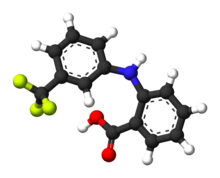 | |
 | |
| Clinical data | |
|---|---|
| AHFS/Drugs.com | International Drug Names |
| Routes of administration | By mouth, topical |
| ATC code | |
| Legal status | |
| Legal status |
|
| Pharmacokinetic data | |
| Protein binding | extensively |
| Metabolism | Hydroxylation, glucuronidation |
| Elimination half-life | ~3 h |
| Excretion | 50% urine, 36% feces |
| Identifiers | |
| |
| CAS Number | |
| PubChem CID | |
| IUPHAR/BPS | |
| DrugBank | |
| ChemSpider | |
| UNII | |
| KEGG | |
| ChEBI | |
| ChEMBL | |
| CompTox Dashboard (EPA) | |
| ECHA InfoCard | 100.007.723 |
| Chemical and physical data | |
| Formula | C14H10F3NO2 |
| Molar mass | 281.234 g·mol−1 |
| 3D model (JSmol) | |
| Melting point | 124 to 125 °C (255 to 257 °F) resolidification and remelting at 134°C to 136°C |
| Solubility in water | Practically insoluble in water; soluble in ethanol, chloroform and diethyl ether mg/mL (20 °C) |
| |
| |
| (verify) | |
Flufenamic acid (FFA) is a member of the anthranilic acid derivatives (or fenamate) class of nonsteroidal anti-inflammatory drugs (NSAIDs).[1]: 718 Like other members of the class, it is a cyclooxygenase (COX) inhibitor, preventing the formation of prostaglandins.[2] FFA is known to bind to and reduce the activity of prostaglandin F synthase and activate TRPC6.[3]
Scientists led by Claude Winder from Parke-Davis invented FFA in 1963, along with fellow members of the class, mefenamic acid in 1961 and meclofenamic acid in 1964.[1]: 718
Although flufenamic acid was at one time informally referred to as "Fluffy" (see history cache), this pet name could also refer to flufenoxine.
- ^ a b Whitehouse MW (2005). "Drugs to treat inflammation: a historical introduction". Current Medicinal Chemistry. 12 (25): 2931–2942. doi:10.2174/092986705774462879. ISBN 9781608052073. PMID 16378496.
- ^ "Mefenamic Acid". LiverTox Database. U.S. National Institutes of Health (NIH). June 23, 2015. PMID 31643176. Retrieved July 3, 2015.
(fenamates generally not available in the United States, such as tolfenamic acid and flufenamic acid)
- ^ "Chemical–Gene Interaction Query: Flufenamic Acid (Homo sapiens)". Comparative Toxicogenomics Database. North Carolina State University. Retrieved July 4, 2015.